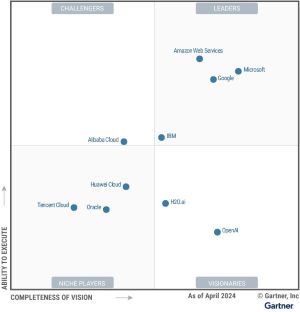News
'Big 3' Dominate Cloud AI Developer Services Research Report
New Gartner research on providers of cloud AI developer services shows the usual cast of characters leading the pack.
Those actors would be the "Big 3" cloud giants: Amazon Web Services, Microsoft and Google, trailed by IBM. Those companies have been in the Leaders section of the company's trademarked Magic Quadrant reports for Cloud AI Developer Services for years.
 [Click on image for larger view.] Magic Quadrant for Cloud AI Developer Services (source: Gartner).
[Click on image for larger view.] Magic Quadrant for Cloud AI Developer Services (source: Gartner).
Microsoft last week noted it had been named a Leader for the fifth year in a row, and Google did the same.
"Software engineering leaders are in dire need of tools that empower their teams to implement AI/ML capabilities into applications," Gartner said in the new report. "Cloud AI developer services (CAIDS) help to bridge the skills gap."
By complementing and augmenting the skill sets of those engineers, the firm said, CAIDs enable them to build applications with predictive, intelligent features with dev services providing:
- Code generation and explanation via models with APIs or through experiences such as IDE plug-ins
- Data preparation to correct data quality concerns, generate missing values when possible, and identify characteristics that prevent responsible AI
- Feature engineering
- Automated ML model building by offering coded and no-code approaches that iterate through algorithms to build and choose the best-performing models
- Model deployment ranges across hosted, on-premises and edge, and monitoring for drift in the model behavior
- LLM fine-tuning and grounding to increase the relevance and accuracy of responses, and to further the use cases where this technology can be implemented
- AI agents that bridge intelligence and actions to assist in customer and employee activities
The report noted that lately the vendors have improved their capabilities in four key use cases:
- Language: Vendors are developing LLMs that can deliver an expanded range of high-quality language services. Major cloud vendors are developing proprietary language models, while smaller vendors are using open-source software, data and ML models to try to compete.
- Vision: Nearly every CAIDS vendor has improved its vision capabilities. The prolific use of computer vision in China has driven immense improvements among China-based vendors in the past year. OpenAI's red team release of Sora in 2024 occurred outside of the research cutoff date, but underlines the vision and roadmaps of technology providers in this market.
- Tabular data: CAIDS vendors are expanding their capabilities in the realm of tabular services, such as increasing data sourcing integrations across native and popular data lake and data fabrics, and releasing compelling services such as synthetic data generation. This allows developers without significant ML or data science skills to customize vendor-provided models or build purpose-specific ML using structured data from the enterprise systems they currently maintain.
- AI code assistants and code models: CAIDS vendors are transforming the software development landscape by releasing AI-powered tools like code assistants and code models. Code assistants serve as ready-to-use tools that enhance code efficiency. Code models are LLMs that have been fine-tuned with code data, acting as a springboard for the creation of custom, innovative applications. These AI tools automate repetitive tasks, bridge the skills gap among developers and integrate with developer workflow tools.
With those improvements, the 2024 Magic Quadrant for Cloud AI Developer Services will be last of that series, which is switching to Magic Quadrant for AI Code Assistants later this year.
Numbers backing up the explosive growth of the AI code assistant space include 28 million professional software engineers worldwide that provide a market of some $10 billion in terms of annual recurring revenue (ARR) even though only 14 percent of those engineers are using them. That AAR number is expected to climb to $12.20 billion by the end of next year.
While Gartner's research reports are typically available only to for-pay clients, licensed-for-distribution Magic Quadrant reports are often made available for free by the companies that are named in them. A quick internet search will find this one (as will links in the Microsoft and Google posts linked above).
About the Author
David Ramel is an editor and writer at Converge 360.